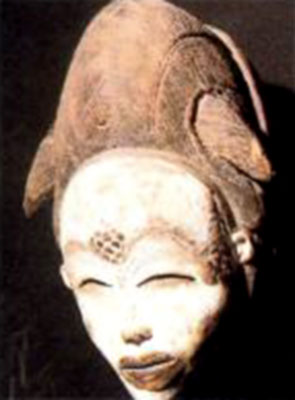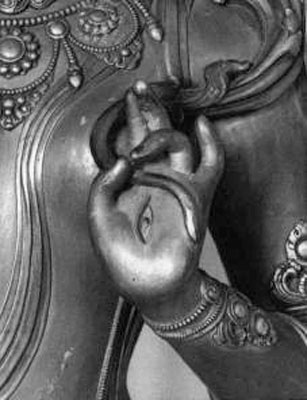|
by John Lash April 2006 - Flanders
revised December 2010 - Andalucía
Throughout Metahistory, I have argued that belief in an off-planet deity is dangerous to human survival, and even to human sanity, because it works against our instinctual bond with the living planet, Gaia.
By correlating Gaia with the goddess
Sophia of the Mysteries, I want to show the ancient provenance of
that bond. Recognition of the Wisdom Goddess as the indwelling
intelligence of the earth is central to the message of
Metahistory.
Neither, but it is a challenge to find in relation to the earth what has previously been found through belief in what lies beyond it.
This is in some respects the credo of Metahistory.
Knowing Gaia is not a matter of belief: it is a vision quest for the entire human species. Recognition of Sophia, the wisdom of the earth, was common to all indigenous peoples in former times.
In the classical age of Pagan religion, Sophia was known by many names:
The names given to Sophia in tribal cultures run into the thousands.
If Sophia is regarded as the divine spirit that animates the entire planet, i.e., the informing intelligence of the biosphere, then we can imagine how the vision quest of our species might unfold:
Bapuna mask of White Goddess Congo
Biomysticism
The return to animism is explicit in the message of Metahistory, but not blind, superstitious animism.
I have proposed the term biomysticism for empathic and visionary participation in the life-force.
In Slanted Truths, Lynn Margulis refers to biomysticism as "debilitating" - which I take to mean that she sees the projection of human feelings upon nature as bad for science - but anyone who has experienced deep rapport with nature, be it through entheogenic rites or simply by watching the sunset, knows that the experience is quite the contrary:
Biomysticism involves a religious attitude toward nature, yes. It
may also be considered as a basic survival technique.
The multi-galaxy Universe (attested in spectacular fashion by the photographs from the Hubble telescope),
...all these factors of leading-edge science can be correlated to Gnostic cosmology.
This is not to say that the mythology needs to be, or can be, validated by science. No, myth is an imaginative tool that works in a different way than science, and serves different ends.
But science, especially
as it relates to Gaia, can acquire richness and resonance by
correlation to the participatory aspects of genuine "creative
mythology," as Joseph Campbell called it.
Modern science denies categorically that such access is possible, but Reich warned that,
I maintain that scientific theory divorced from the body and senses will only lead to confusion and contradiction.
In The Science of Yoga, a commentary on the Yoga Sutras of Patanjali, I. K. Taimni says,
Reich also warned against mysticism, of course, and in no uncertain terms:
In The Mass Psychology of Fascism and The Murder of Christ, Reich argued that mystical obsessions capable of infecting entire populations or races arise due to "projections of unnatural, distorted organ sensation."
In other words, people can attribute to
forces in a world beyond what they are actually feeling in their own
bodies, but they deny the feeling because its ego-dissolving
intensity frightens them. Or even because the sheer pleasure of inorganic embodiment frightens them.
In his insistence that "orgastic potency" is essential to a sane society, Reich seems to have recalled (perhaps subliminally) the ancient custom of sacred mating in which the candidate for kingship was tested by sexual congress with a priestess representing the Earth Goddess (or the Earth itself, if you will).
The man's willingness to surrender to the pleasurable
streaming of the life-force was the proof of his potency, the power
to rule with courage, wisdom, and tenderness.
In The Sleepwalkers, a classic work on the birth of modern science, Arthur Koestler explains how Kepler substituted gravity for the theological conception of the Holy Ghost. Koestler does not note, however, that the Holy Spirit was understood in the Mysteries to be identical with Sophia, the Wisdom Goddess whose body is the Earth.
Describing the beliefs of the Barbelo-Gnostics, Irenaeus said,
Significantly, Reich associates life-affirmative mysticism with planetary physics. (Reich's last book, Contact with Space, records his investigations of UFOs and anomalous phenomena in the atmosphere.)
This is certainly due to his own first-hand experience
of cosmic orgone streaming in the atmosphere of the Earth. I would
call life-negative mysticism dissociative or sado-mysticism, for it
is almost always connected with sadistic impulses, either covert or
overt.
The
greatest mystery of science is what unfolds in the human senses, but
the investigation of that mystery is not uniquely the province of
scientists.
In Mythbusting 101, a series of lessons that chart the future direction of this side, I am developing the mythical-literary theme of the Wasteland in connection with the hero of the Grail Quest, Parzival.
The French and German Grail literature of the 12th Century grew from specific mythological origins in Ireland and Wales where the Mysteries survived after their repression by the Roman Church.
The theme of the Wasteland is a Celtic variant of the universal
identification of woman with the Earth, but it takes a unique spin.
Today we may choose to see the evil enchantment of the Grail Legend as the pollution of the biosphere, but psychologically speaking, the spell operates in our own minds, in our perception of nature, as much as in nature itself.
The key term here is desacralization.
We ourselves put the entire Earth under a spell when we cease to acknowledge the sacred power of nature, or surrender to its beauty as if melting in orgasmic delight.
This being so, it is essential to recover the mystical and religious element of human experience by infusing Gaia theory imaginatively with a sacred element. I am convinced that imaginative or imaginal participation will lead to sensuous contact with the living planet, and this in turn will lead to sensory illumination.
Everything we can do to unspell the Earth depends on what A.E. called "vital contact" with the atmosphere, the terrestrial envelope in which we live and breathe - or which is breathing us, if you will.
In 1984, alchemist and mystic Adam McLean wrote:
It would be incorrect to speak of resacralization, because nature has never not been sacred in its own right, but we do need to resacralize our perception of the natural world.
This is the
non-scientific opportunity offered by the Gaia mystique, no matter
what its pitfalls and drawbacks may be. Psychosomatic illumination
through Gnosis is also a path of science (literally, "knowing"), a
path that does not in any way preclude the methods of science and
may in fact complement them.
The Sophianic vision of the Earth can enhance science by adding human participation and empathy to instrument-supported research, data accumulation, mathematical modeling, and the logical-analytical proof process
Those who would argue that empathy with nature is contrary to objective science do so at the risk of endorsing a disembodied, inhumane type of science. This approach recalls the insistence by Frances Bacon that we torture nature, "put her on the rack," in order to extract her secrets.
This cold, inquisitorial attitude is consistent with the off-planet metaphysics demonstrated by salvationist religion since the Middle Ages, and adopted by science since the Enlightenment.
As Theodore Roszak observed:
The alliance of mysticism and science was anticipated by Fritjof Capra in The Tao of Physics, published in 1975, but Gaia theory, chaos, emergence, plasma cosmology, exobiology, and other factors had to come together before we could see the possibility, and accept the necessity, of such an alliance.
Capra's book was a flare that momentarily lit up the horizon, but it did not show us the complete lay of the land. It emphasized the homology of scientific and mystical propositions and conceptual structures, without considering how the human senses might reveal the intrastructure and operative laws of the cosmos in ways that cannot be expected from scientific instruments.
Now that the territory is more well-defined, we can
accept what others before Capra (most notably, Goethe, followed by
Wilhelm Reich and D. H. Lawrence) had foreseen: science in the
future will adopt the senses as tools rather than disregard them as
sources of deceptive data.
In my new book, Not in His Image, I define ecognosis as,
This definition links the human capacity for deep rapport with nature with the central theme of Gnostic cosmology, the "correction" of Sophia.
In making this link, I do not posit or propose what the "correction" is; nor did Gnostics make this matter explicit (not in any surviving writings, at least), except to suggest that it somehow involves the relation of the earth to the galactic center, the Pleroma.
Sophia's correction is what the Gaian vision quest of our species
will lead us to discover.
Unfortunately, Gnostic scholars do not look outside their special field to interpret Gnostic writings.
No legitimate scholar would make the correlations I am proposing, but then, no legitimate scholar is capable of making such correlations, either, due to the blinders they wear. For instance, my basic assertion that Gnostics were the senior instructors and guardians of the the Levantine Mysteries goes beyond the limits of Gnostic scholarship.
But I resolutely contend
that the origin, nature, methodology, and aim of Gnosis is
incomprehensible without correlations of the kind I have developed.
For each point considered, I summarize the consensus view held by Gnostic scholars, the ecognostic view proposed in this site, and the leading correlations to Gnostic theory and practice to be found in shamanism and Asian yoga and Tantra (exclusive of Bon Po, Dzogchen, and Vajrayana which, though they present startling parallels to Gnosis, tend to be too heady and complicated).
All points in the ecognostic category are derived
directly from textual evidence of Gnosticism. In other words, they
present my extrapolations of Gnostic teachings selected with a bias
for non-Christocentric, Sethian Gnosticism.
|


